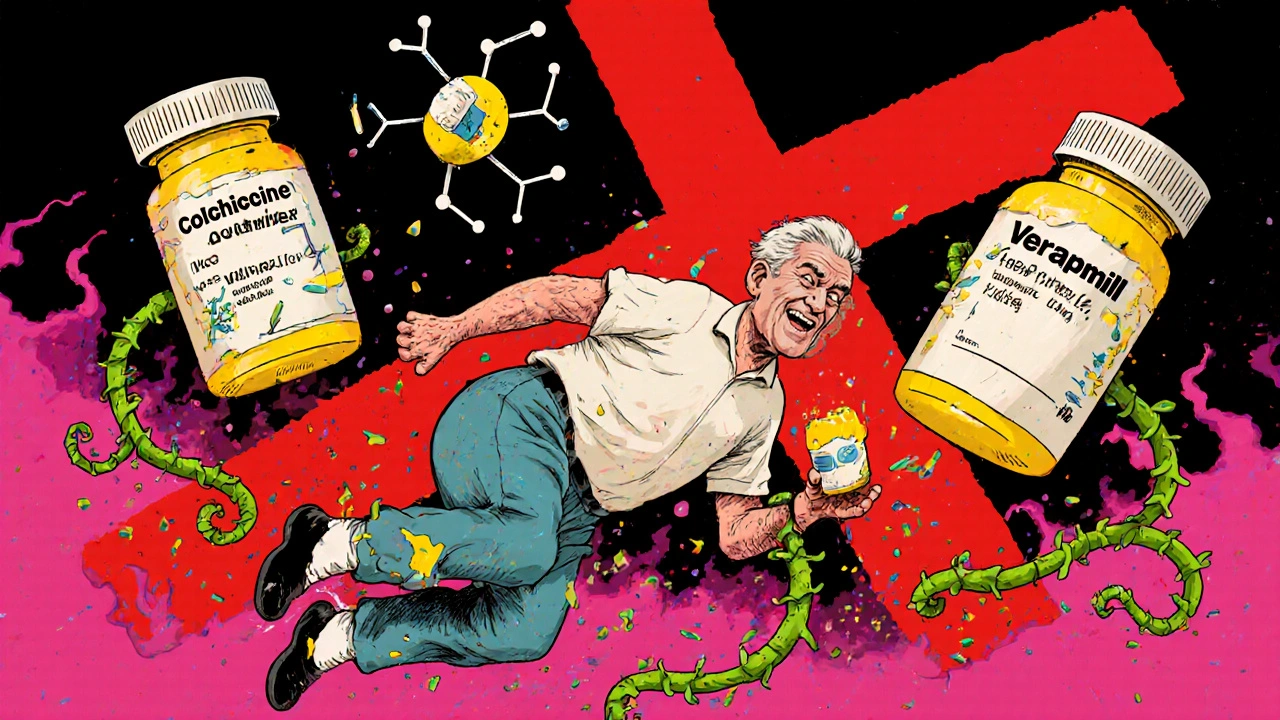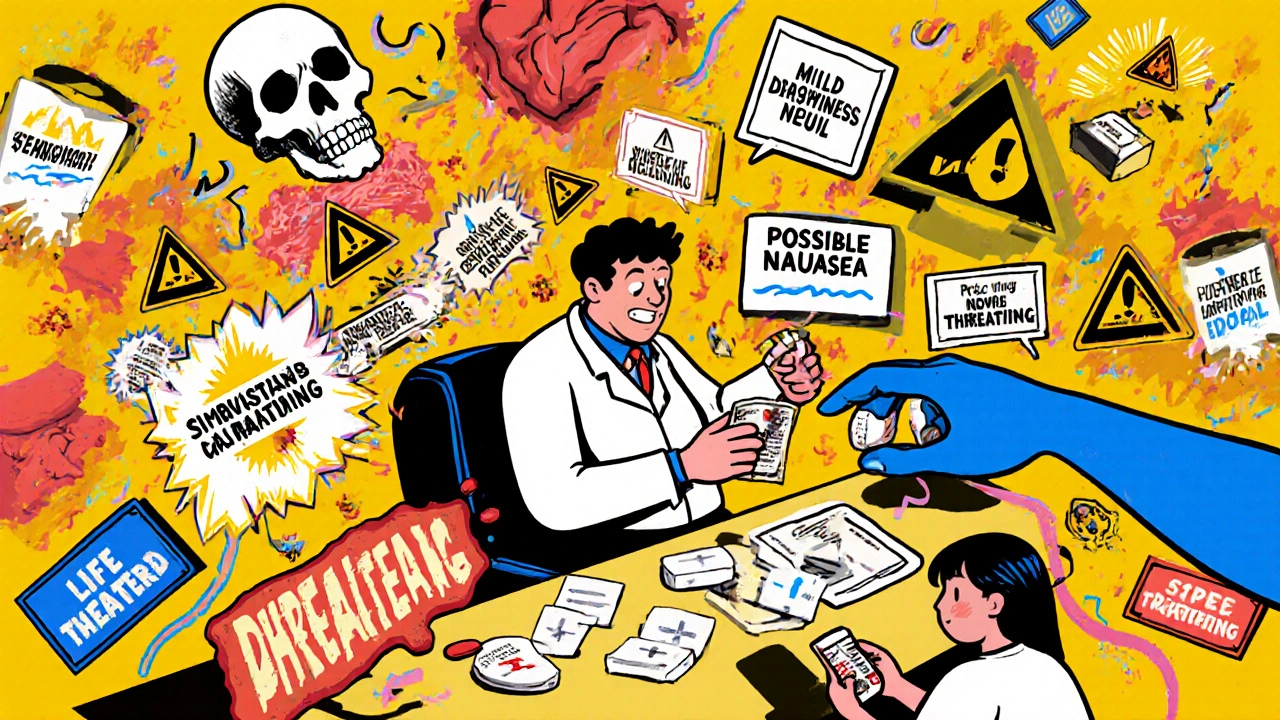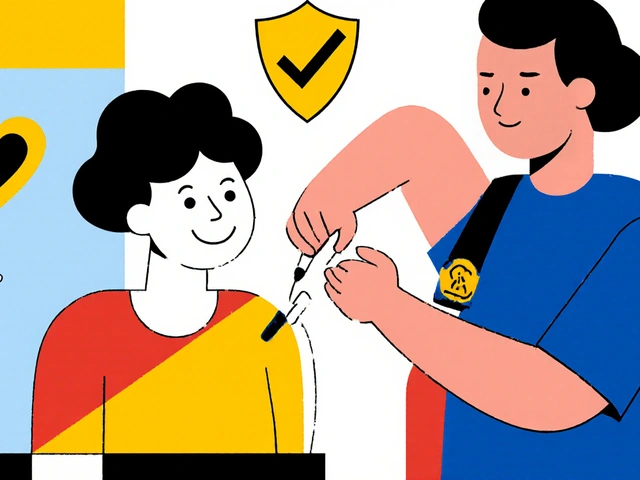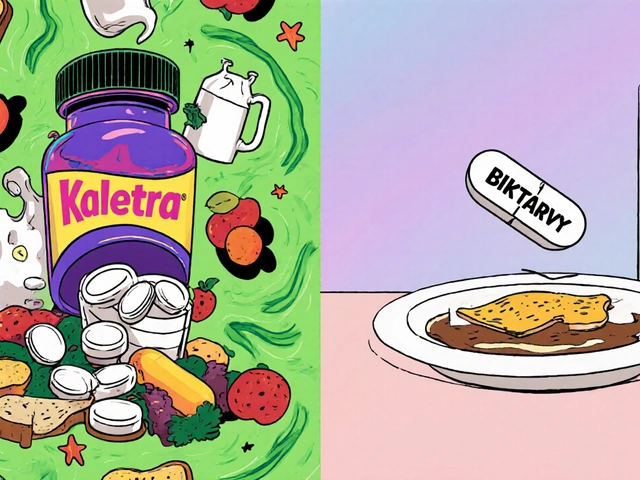Drug Interaction Checker
Check Medication Safety
Enter two medications to see if they create a dangerous interaction. This tool is based on the 5 deadly combinations highlighted in the article.
Every year, tens of thousands of people in the U.S. end up in the emergency room-not because of an accident, but because two perfectly legal medications were taken together. And in many cases, the pharmacist who filled the prescription never saw the danger coming.
It’s not that pharmacists are careless. It’s that the system is broken. Computer alerts flood their screens with hundreds of warnings every day. Most are harmless. A few are life-or-death. And when you’re juggling 150 prescriptions a shift, it’s easy to miss the ones that matter.
Here are five dangerous drug combinations that should set off alarms in every pharmacy. If your pharmacist doesn’t question these, they should.
Simvastatin + Clarithromycin: The Silent Muscle Killer
Simvastatin is one of the most common cholesterol pills. Clarithromycin is a standard antibiotic for sinus infections or pneumonia. Together, they can trigger rhabdomyolysis-a condition where muscle tissue breaks down and floods your kidneys with toxic proteins.
Studies show creatine kinase levels can spike above 10,000 U/L in severe cases. Normal is under 200. At that level, kidney failure isn’t just possible-it’s likely. And once it starts, it can kill within days.
This isn’t theoretical. In 2016, a Chicago Tribune investigation found pharmacists at CVS and Walgreens dispensed this exact combo without warning. The reason? The computer flagged it, but the pharmacist clicked past it. Too many alerts. Not enough time.
Colchicine + Verapamil: A Slow-Motion Poison
Colchicine helps with gout flare-ups. Verapamil lowers blood pressure. Both are safe alone. Together, they’re a ticking time bomb.
Verapamil blocks a protein called P-glycoprotein that normally flushes colchicine out of your body. When that’s shut down, colchicine builds up to toxic levels. Symptoms start with nausea and diarrhea-but quickly turn to muscle weakness, irregular heartbeat, and multi-organ failure.
There’s no safe dose when these two are mixed. Even low doses of colchicine become deadly. The FDA has issued multiple warnings about this combo, yet it still shows up in prescriptions. Why? Because doctors don’t always know. And pharmacists are drowning in alerts.
Tizanidine + Ciprofloxacin: The Collapse Risk
Tizanidine is a muscle relaxer. Ciprofloxacin is a broad-spectrum antibiotic. Both are prescribed for pain and infection. But when taken together, they can cause sudden, complete loss of consciousness.
The problem? Ciprofloxacin blocks the CYP1A2 enzyme, which is the only way your body breaks down tizanidine. Without it, tizanidine levels can jump 10-fold. One patient in the Tribune investigation passed out while walking out of the pharmacy. Another fell and broke their hip.
There’s no warning label strong enough to stop this. Only a pharmacist who stops, thinks, and asks, “Why is this patient on both?” can prevent disaster.

Clarithromycin + Ergotamine: The Vascular Emergency
Ergotamine is an old migraine drug. Clarithromycin is a common antibiotic. But mixing them can trigger ergotism-a rare but brutal condition where blood vessels constrict so tightly, limbs turn blue, then black.
It’s like frostbite, but inside your body. Tissue dies. Amputations happen. Death follows if not caught early.
This combo is banned in many European countries. In the U.S., it’s still prescribed because the warning system doesn’t flag it consistently. Pharmacists don’t always know ergotamine is even in the mix-many patients take it as a tablet, not realizing it’s the same as the migraine injection they were told to avoid.
Birth Control + Griseofulvin: The Unintended Pregnancy
Griseofulvin is an old antifungal used for stubborn nail or scalp infections. It’s rarely prescribed now-but still shows up. And when it’s paired with birth control pills like norgestimate/ethinyl estradiol, it can turn contraception into a gamble.
Griseofulvin speeds up how fast your liver breaks down estrogen. Studies show pregnancy rates jump above 30% when these two are combined. Worse, if pregnancy happens, the risk of birth defects increases.
Most patients don’t know. Most doctors don’t remember. And most pharmacists? They’re too busy to check the interaction database for an antifungal no one uses anymore.
Why This Keeps Happening
The problem isn’t ignorance. It’s overload.
Pharmacists today get an average of 120 drug interaction alerts per day. Over 80% of them are low-risk-like “this drug might cause mild drowsiness.” That’s noise. And noise makes people blind.
After the 2016 Chicago Tribune investigation exposed that 52% of pharmacies missed life-threatening combos, big chains like CVS and Walgreens promised change. They added mandatory checks. They trained staff. But the core issue remains: the same broken software that flooded screens with useless alerts is still running.
Professor John Horn from the University of Washington School of Pharmacy tested a fix: filter alerts by severity. Only flag the ones that can kill. The result? Alerts dropped by 78%. Critical interactions caught went from 48% to 89%.
That’s not magic. That’s common sense.
Who’s Most at Risk?
Older adults. That’s who.
People over 65 take an average of 4.5 prescription drugs a day. That’s not unusual. That’s normal. But every extra pill adds another chance for a deadly mix.
The FDA says older adults are seven times more likely to have an adverse drug event than younger people. And it’s not just the drugs-it’s how they’re taken. A 78-year-old with arthritis, heart disease, diabetes, and high cholesterol might be on eight medications. One new antibiotic from the urgent care clinic? That’s all it takes.
Children, pregnant women, and people with liver or kidney disease are also high-risk. But older adults are the most visible-and the most vulnerable.
What You Can Do
You don’t have to wait for the pharmacist to catch it. You can be the safety net.
- Always tell your pharmacist every medication you take-prescription, over-the-counter, supplements, herbal remedies. Even that turmeric pill.
- Ask: “Is this safe with everything else I’m on?” Don’t wait for them to ask you.
- Use one pharmacy for all your prescriptions. That way, they build a full picture of your meds.
- If you’re on blood thinners like warfarin, ask if any new drug affects INR levels. Amiodarone, fluconazole, and even some statins can make warfarin dangerously strong.
- Keep a printed list. Show it to every new doctor and pharmacist. Don’t rely on memory.
And if you’re on one of the five combos listed above? Walk back to the counter. Say, “I think this might be dangerous.” If they hesitate, ask to speak to the pharmacist on duty. Don’t leave until you get a clear answer.
The Bigger Picture
This isn’t just about five bad combos. It’s about a system that treats patients like data points.
Every year, 1.3 million Americans visit the ER because of preventable drug reactions. 350,000 are hospitalized. The cost? Over $500 billion annually.
AI tools are starting to help. The FDA is funding systems that look at your full medical history-not just two drugs-but they’re not everywhere yet.
Until then, the only thing standing between you and a deadly interaction is a pharmacist who’s been trained, has time, and isn’t drowning in false alarms.
Be your own advocate. Ask the question. Demand the check. Your life might depend on it.
Can over-the-counter drugs cause dangerous interactions too?
Yes. Many people assume OTC meds are safe, but that’s not true. Ibuprofen can increase bleeding risk when taken with warfarin. Decongestants like pseudoephedrine can spike blood pressure if you’re on certain heart meds. Even St. John’s Wort can make birth control, antidepressants, or transplant drugs fail. Always check with your pharmacist-even for pills bought at the grocery store.
Why don’t doctors catch these interactions before prescribing?
Many doctors use electronic prescribing systems that do flag interactions, but they’re not perfect. Some alerts are ignored because they’re too frequent. Others don’t include all medications a patient is taking-especially supplements or drugs from other doctors. A patient might see three different specialists, each prescribing without knowing the full list. Pharmacists are often the last line of defense because they see the complete picture.
Are generic drugs safer than brand names when it comes to interactions?
Yes and no. Generic drugs contain the same active ingredient as brand names, so the interaction risk is identical. A generic simvastatin interacts with clarithromycin just like the brand version. The difference is in fillers or coatings-none of which affect how the drug works in your body. Don’t assume generics are safer. Always check the active ingredient.
What should I do if I’ve already taken one of these dangerous combos?
Stop taking the combination immediately and contact your pharmacist or doctor. Don’t wait for symptoms. For combos like simvastatin + clarithromycin or colchicine + verapamil, damage can start within hours. If you feel sudden muscle pain, weakness, dark urine, dizziness, or irregular heartbeat, go to the ER. These are signs your body is under stress from the interaction.
Is there a way to check drug interactions myself before filling a prescription?
You can use trusted tools like the FDA’s Medscape Drug Interaction Checker or Micromedex, but they’re not foolproof. They don’t know your full medical history-like kidney function or other conditions that change risk. They also don’t account for timing (like taking one drug in the morning and another at night). The best check is always a pharmacist who has your full profile. Use apps as a backup, not a replacement.



November 23, 2025 AT 00:23 AM
Bro this is why I only take Tylenol and hope for the best.